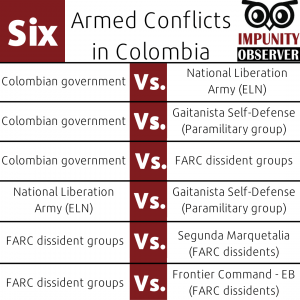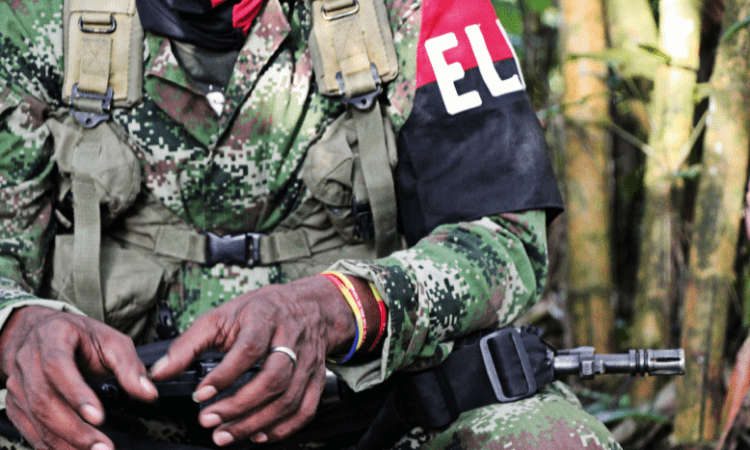Colombia is descending toward failed-state status, with rising political violence and many areas of the country abandoned by the national government. A 2021 UN report documented a return to 2016 levels of violence, which occurred during the negotiations with the Revolutionary Armed Forces of Colombia (FARC). Dozens of gangs—both narco guerrillas and vigilante paramilitaries—are acting defiantly and aggressively. This violence is undermining what precious little stability Colombia has and the legitimacy of the 2022 legislative and presidential elections.
This investigation seeks to explain why violence is rising of late, especially as it relates to and derails the 2022 electoral process. Various factors have converged to heighten political violence in Colombia, including:
- power vacuums in state-abandoned territories;
- coopted officials of the neighboring Venezuelan dictatorship;
- unforeseen consequences of the 2016 FARC deal;
- revenues from record cocaine production and trafficking.
On March 8, Michelle Bachelet, the UN high commissioner for human rights, expressed concerns about the spike in violence against social leaders in predominantly rural areas. Bachelet urged the Colombian government to dismantle organized criminal groups and streamline its response to civilian complaints.
Guerrillas emerged six decades ago in Colombia. Given their lengthy histories with longstanding battles between each other and with provincial and central governments, these criminal groups have become hardened, well organized, and sometimes embedded in the government. They have consolidated territorial dominance and economic power to make their ventures sustainable. The Corruption Perceptions Index scores Colombia 39 out of 100. That is 87th in the world, alongside mainly African nations such as Ethiopia and Morocco.
Before 2016, the Colombian state faced two or three major armed groups, most notably the FARC and the National Liberation Army (ELN)—in addition to a handful of drug cartels. However, since the FARC deal (also known as the Havana agreement) and amnesty, other armed groups have taken over FARC territories. Some of the same people are involved, merely under different guises and in splinter groups such as the self-described FARC dissidents. The end result is that these groups are generating even more violence.
Colombia faces six major armed conflicts, although not all the factions are well known and established (see the diagram). As of 2021, Colombia has an annual reported murder rate of 26.8 per 100,000 residents. This is on par with the highest rates in the world—such as Venezuela at 40.9 per 100,000—and double the rates in neighboring Ecuador and Panama: 14.0 and 12.8, respectively.

Electoral Overview
The electoral process in Colombia began a year before the legislative elections when Colombia’s National Registry published the official electoral calendar. Candidates had until December 2021 to officially register. The initial legislative elections—including 102 seats in the Senate and 166 in the House—took place on March 13, 2022. The presidential election is set for May 29, with a runoff vote on June 19.
In the Senate, Historical Pact (HP), an anti-capitalist coalition, and the Conservative Party won 16 seats each. The Liberal Party, the Green Coalition, and the Democratic Center—centrist and right-leaning parties—won 15, 14, and 14 seats, respectively. These parties occupy more than two-thirds of the Senate. The Havana agreement granted FARC guerrillas five seats in the Senate and five seats in the House until 2026.
The representation in the House will be spread across even more parties than in the Senate. In this election, indigenous groups in Transitory Special Peace Districts (CITREPs) selected their own representatives in accordance with the Havana agreement. The Liberal Party won 32 seats; HP and the Conservative Party won 25 seats each.
In the May 29 presidential election, a winning candidate must obtain more than 50 percent of the votes. If no one succeeds, which appears to be the most likely outcome, a runoff election between the two most popular candidates will be held on June 19.
Acute Coercion
According to a report by the Peace and Reconciliation Foundation (PARES), 144 cases of electoral violence have occurred in Colombia since March 13, 2021—the year leading up to the legislative elections. Armed groups murdered 22 people, including politicians and journalists around the country. For comparison, in the last legislative elections in 2019 PARES reported 116 cases of electoral violence, including 20 murders.
Regional and local news outlets have reported several instances of violent threats and breakdowns in the rule of law amid the electoral period. This includes vote-buying and electoral fraud relating to CITREP candidates. For example, an armed group kidnapped Guillermo Murcia, a CITREP candidate, in Arauca in February. Hours later, as news spread and amplified the intimidation, the gang released him.
On election day, two military officials died and three others were injured in two bomb explosions in La Macarena, Meta, and San Vicente del Caguán, Caquetá. “Armed groups use these attacks, especially in rural areas, to demonstrate their power and make a statement to politicians,” says Carlos Augusto Chacón, academic director at the Political Science Institute in Colombia (ICP).
Deeply Rooted in Colombian History
The spate of political violence in recent years is far from a new experience for Colombia. Sophisticated black-market business, narcos, and paramilitaries have grown to be part of the nation’s identity, but they are the modern iteration of a nation accustomed to profound conflict. As early as 1900, Colombia had suffered through nine civil wars, primarily conflicts between the Liberal and Conservative political parties.
In the twentieth century, the conflict between Liberals and Conservatives escalated. The so-called Bogotazo represents the period in which Juan Roa murdered Liberal Party presidential candidate Jorge Eliécer Gaitán in 1948, which resulted in a crime wave across Bogotá, Colombia’s capital city. In 1958, the Liberal Party and the Conservative Party signed the Benidorm Pact, which established alternating power every four years to avoid conflict. This lasted until 1974.
The Cold War and the spread of communist ideology from Cuba catalyzed Marxist guerrillas in the 1960s, each tending to focus on particular regions of the country. The FARC was founded in 1964, the ELN in 1965, and the now-defunct Popular Liberation Army (EPL) and April 19 Movement (M-19) in 1966 and 1973, respectively.
In the 1980s, to combat guerrilla violence, vigilante paramilitaries emerged. Some worked as private security. The largest paramilitary group was the United Self-Defense Forces of Colombia (AUC), which disbanded in 2006. Many of these groups fought guerrillas to protect landlords from theft, extortion, and aggression.
The line between paramilitaries and guerrillas, however, became blurred as paramilitaries got into bed with drug traffickers and sympathized with guerrilla causes. The black market for drug production and trafficking made organized violence profitable and left few legitimate groups simply acting as private security.
In the twenty-first century, with Álvaro Uribe’s arrival to the Colombian presidency, the FARC struggled to survive. The US-funded Plan Colombia and Uribe’s firm hand, which included the killings of guerrilla chiefs, debilitated not only the FARC but other guerrillas such as the ELN and the M-19. Paramilitary groups also found themselves in the government’s cross hairs and diminished in size.
In 2019 and 2020, the Iván Duque administration faced some of its stiffest opposition. Bogotá and Cali dealt with continuous riots for more than four months. Demonstrators requested a higher public education budget and protested against rising levels of violence, especially in CITREP districts. Three people died and over 200 were injured, all civilians.
Similarly, in April 2021, massive riots surged in some of Colombia’s largest cities such as Bogotá, Medellín, Cali, Barranquilla, and Cartagena. Demonstrators showed their discontent over a law reform that would have raised taxes slightly in Colombia.
Strikes became violent. In Cali, the police and the rioters used aggressive approaches. As a result, a regional news outlet reported 63 deaths nationwide, of which two were police officers and the rest civilians.
The Agreement Sours
In an attempt to nullify armed groups when they were weak, in 2016 the Colombian government under President Juan Manuel Santos sought a peace accord. His team negotiated this in Havana, Cuba, with the Marxist-Leninist FARC and, against the wishes of Colombians, agreed to major concessions.
Chacón of ICP told the Impunity Observer that the FARC deal’s shortcomings have been a major trigger for today’s violence. While the government granted amnesty to FARC terrorists, they never upheld their side of the agreement. Chacón contends, for example, that the FARC have never come clean and detailed their crimes and methods with Colombians.
Santos, while negotiating with the FARC, reduced armed pressure on the guerrillas. Amid the negotiations, the FARC expanded their operations across the country without a ceasefire agreement. After the government and FARC signed the Havana agreement, new dissident groups emerged across the country. So-called FARC dissidents are former FARC factions that did not subscribe to the Havana agreement, so they continue terrorizing the population and surviving on illicit trade.
In provision 2.3.6. of the Havana agreement, the government promised the creation of CITREPs to promote diverse representation in national politics. The constituents of CITREP representatives in the Senate and House are from the geographical regions most affected by the armed conflict. Some of the districts are Nariño, Chocó, Putumayo, Magdalena, Caquetá, Arauca, and South Bolívar.
Due to lawlessness faced in these districts, the CITREPs have been a controversial provision of the Havana agreement. Chacón says the CITREPs are a complex topic to analyze. The candidates do not belong to a specific political party but rather represent victim groups in the form of tribal and local organizations. It is difficult, however, to define who exactly the victims are because some have ties to guerrillas and are victims of paramilitary groups or vice versa. Chacón contends the CITREP districts are still strongholds of armed groups such as FARC dissidents.
The Havana agreement negotiations were not the first of their kind with guerrillas. Former President Belisario Bentacur also negotiated with FARC, the M-19, and other armed groups. These negotiations failed from a lack of political support. Former President Andrés Pastrana also held negotiations with the ELN between 1998 and 2002, but they too were ineffective. All the negotiations proposed the retreat of Colombian law enforcement from specific regions to alleviate pressure on guerrillas.
After all these efforts, the ELN and other armed groups are more active and better manned than ever before. Since the FARC agreement, Mexican cartels have also expanded into power vacuums in Colombia. In addition to their own boots on the ground, they have hired paramilitaries, FARC dissidents, and ELN members to access Colombia’s burgeoning cocaine production.
Ever-Present Venezuela
Venezuela, under the Chavista dictatorship, has already achieved failed-state status, and the mass exodus for many years has been flowing into neighboring nations. However, the Colombian state has also abandoned cities along the border with Venezuela as they have descended into chaos and lawlessness.
Likewise, Colombian gangs have seized the opportunity to set up shop across the border—away from Colombian law enforcement—and poach Venezuelan resources via illegal mining. Human trafficking has become a new income source for these armed groups. They control trochas, illegal passages across the border, with migrants paying a fee to cross.
Eduardo Battistini, a member of Juan Guaidó’s shadow presidential administration for Venezuela, reported in February that Nicolás Maduro’s officials were providing Venezuelan IDs to guerrillas. There is also widespread reporting of guerrillas possessing Venezuelan identification, which is consistent with collaboration between Maduro’s regime and Colombian armed groups.
In 2019, Semana Magazine unveiled a classified letter by Maduro’s intelligence agency. The letter warned Venezuelan military officials, “by the order of President Nicolás Maduro Moros, you should avoid conflict with the red groups in training zones. Instead, you should give them logistical support and training.” According to the magazine, red groups in the regime’s parlance refers to the FARC dissidents and the ELN.
In February 2021, Álvaro Díaz—ELN leader—explicitly confirmed in a video the ELN’s support and loyalty towards the Venezuelan dictatorship. He also requested that the regime trust the ELN and its army.
Later that year, Semana Magazine got full access to FARC dissident Miguel Botache’s computer. Journalists found documents that further reveal cooperation between the Chavista regime and Colombian guerrillas. These documents show FARC dissidents asking for support to neutralize Colombian and US raids.
According to Bram Ebus—a consultant at International Crisis Group (ICG)—there is a tacit agreement between the Venezuelan dictatorship and these groups. “These groups do not see an enemy in the Venezuelan army, as they do in the Colombian one,” explains Ebus.
Ebus highlights the importance of Venezuela to armed groups due to the country’s resources, strategic location, and complicit government. Colombian cartels have a stronghold in Venezuela and have started to recruit children and teenagers from the country, while the sympathetic regime looks away.
Conclusion
The rising violence in Colombia is due to multiple factors, and it stems from a long history of domestic conflict. To some extent it is political, but it is also a power play from organized criminals jockeying for dominance. The so-called peace agreement appears to have, in the end, contributed to the violence. By providing safe haven and a lawless frontier, Venezuela’s failed and corrupt state plays a major role in strengthening Colombia’s armed groups. Further, the lack of Colombia’s state presence in conflict regions when the FARC signed the Havana agreement has led to the emergence of new armed groups where the FARC once dominated.
 Join us in our mission to foster positive relations between the United States and Latin America through independent journalism.
Join us in our mission to foster positive relations between the United States and Latin America through independent journalism.
As we improve our quality and deepen our coverage, we wish to make the Impunity Observer financially sustainable and reader-oriented. In return, we ask that you show your support in the form of subscriptions.
Non-subscribers can read up to six articles per month. Subscribe here.



